Are you wondering what it’s like to visit Lisbon in February?
We moved to Lisbon in 2022 and have had the good fortune to experience life in the city during different parts of the year.
December is probably the busiest winter month in Portugal, with tourists coming to Lisbon for Christmas. In February, you’ll experience a quieter version of Lisbon.
I love the low season in Lisbon because it means I can visit all the top attractions without worrying about the stress of queuing or wading through crowds of people.
Let’s explore a variety of cool things to see, do, and eat in Lisbon in February to help inspire your late-winter trip.
What is the weather like in Lisbon in February?
Lisbon in February is definitely marked by cooler temperatures. Expect jacket weather, but the sun often comes out to reveal beautiful clear blue skies.
February is a great time to visit Lisbon if you're looking for an escape from colder climes. The average temperature in February is 12°C (54°F), with highs of 16°C (61°F) and lows of 9°C (48°F). There is an average of 8 days of rain in February, but the rain is usually light and sporadic.
If you're planning on spending time outdoors, be sure to pack a light jacket or sweater. I recommend bringing an umbrella, just in case. But overall, the weather in February is mild and pleasant, making it a great time to explore Lisbon's many attractions as you'll soon see.
Here are a few things to keep in mind about the weather in Lisbon in February:
- The weather can change quickly, so it's a good idea to be prepared for anything.
- The days are getting longer in February, so you'll have plenty of time to explore the city.
- The beaches are still a bit chilly in February, but you can still take a walk along the river or the coast if you bundle up.
Things to do in Lisbon in February at a Glance
Table of Contents
- Shop for Bargains
- Sip Coffee Indoors or Out
- Head to a Craft Beer Bar
- Explore Pimenta Palace
- Stroll Jardim Bordallo Pinheiro
- Have Dinner at a Local Taberna
- Take a Walk in Parque Eduardo VII
- Browse Mercado de Santa Clara
- Tour Mosteiro São Vicente de Fora
- Sit Down for a Sunset Drink at Taproom Oitava Colina
- Ride Elevador da Bica to Time Out Market
- Cocktails at 18.68
- Go for a Romantic Day-After-Valentine's Day Dinner at Palacio Chiado
- Grab a Margarita at Oyster and Margarita
- Visit the Old Pharmacy
- Go to the Lisbon Comedy Meet-up in Alcântara
- Eat Brunch at Olivia
- Browse the Historic Shops of Chiado
- Enjoy an Atmospheric Coffee at Cafe Brasileira
- Peek Into Igreja de São Roque
- Head to a Rooftop Bar
- Take a Photowalk in São Bento
- Dine at El Cortes Ingles Gourmet Hall
- Grab Dinner with Friends at Cantinho do Avillez
- Sample Local Wines at Vino Vero
- Walk Along the Ascensor da Bica Route
- Enjoy Empanadas and a Cocktail at Empanar Empanadas
- Visit the Prime Minister's Official Residence (O Palacete de São Bento)
- Sit Outside at Cockpit Quiosque
- Grab a Specialty Coffee at Simpli in Picoas
- Have a Casual Dinner at Rice Me
- Grab a Fresh-Baked Loaf of Bread
- Have Cocktails at the Evolution Hotel
- Visit Good Company Books
- Take a Walk in Campo de Ourique
- Explore Mercado de Campo de Ourique
- Enjoy a Pastel de Nata at Manteigaria
- Have Breakfast at Honest Greens
- Visit Defuse, a Board Games Bar and Cafe
- Go for a Photo Walk to Capture Portuguese Sidewalks
- Check out Kiosk Cafe in Arroios
- Attend a Music Night at Mīrari
- Spend Time at the Lisbon Zoo
- Have Dinner at Gurkha
Things to do in Lisbon in February in Detail
Let's explore cool things to do in Lisbon in February in more detail. I've actually done all of these things in the month of February, so they are tried and tested for this time of year.
1. Shop for Bargains
In January and early February you'll find major sales in Lisbon, so stock up on winter gear before the cold weather ends. You can also start thinking about warm days ahead and perhaps start looking into your summer wardrobe.
Take the Lisbon Metro to Alameda and walk up Avenida Guerra Junquiero where you can explore a wide range of clothing and home stores.
2. Sip Coffee Indoors or Out
If you are feeling adventurous in February, it is still possible to get a coffee outside at a local kiosk in Lisbon, as there are kiosks in most major parks and green spaces around the city. Even if you are wearing a hat, scarf, and a warm coat, it is pleasant to sit in the sun and get some fresh air.
If you are not feeling up to sitting outside in the cold, you can also stop by a local Portuguese cafe like Portela, where you can get a well-made cappuccino made with specialty beans with a Portuguese twist, as well as some delicious Portuguese pastries.
3. Head to a Craft Beer Bar
Another fun thing to do in Lisbon in February is stop into a local craft beer bar. There's one called Cerveteca Lisboa on Avenida de Paris, not far from Avenida Guerra Junquiero where we were shopping earlier.
Here they have about 10 craft beer taps and tasting flights are available with five beers for 10 euros or 10 beers for 19 euros. The taps are a mix of Portuguese and international beers like Leffe from Belgium.
The decor is cool with a stenciled graphic on the wall featuring a crow and sunglasses holding a pint among other characters.
My grandmother wasn't a beer drinker but she was definitely a quilter and so I really liked the quilt square featuring 20 different pint glasses hanging on the wall at Cerveteca Lisboa.
I also recommend spending a Sunday afternoon at Canil, another craft beer bar in Lisbon. You'll find a variety of brews on tap and you can either order from the bar or you can charge up a card and pour yourself varying size draws of the different beers on offer.
Canil also serves a variety of hamburgers so you can definitely get a bite to eat to go with your your weekend beer.
Attend a local meetup at AMO Brewery and then head out with some newfound friends to Ajitama Ramen Bistro, one of the best ramen places in Lisbon in my opinion. Slurp the warm broth to warm yourself up after mingling outside at the brewery. AMO has limited indoor seating.
4. Explore Pimenta Palace
If you're looking for a fun activity to do in Lisbon in February, you can visit Pimenta Palace, which houses the Museum of Lisbon. The palace is located near Campo Grande, a short walk from the Campo Grande metro station.
Admission to the museum is €3 for standard tickets, but residents of Lisbon can get in for free on Sundays and public holidays until 2:00 p.m.
The mission of the Museum of Lisbon is to arouse curiosity about the site of Lisbon and its human occupation over time, as well as its relationship with the Tagus River. The museum interprets the city's multicultural heritage, past and present, through material and immaterial exhibits.
Pimenta Palace was commissioned by Diogo de Sousa Mexia and built between 1734 and 1746. The building has had several owners over the years, and in 1833 it was acquired by Manuel Joaquin Pimenta, hence the name by which it is known.
In 1962, the Lisbon City Council purchased the building to house the city museum, which had been located in the Palacio da Mitra since 1942. The new museum opened to the public in 1979.
The museum's permanent exhibition aims to provide a chronological overview of the human occupation of the area that today corresponds to the municipality of Lisbon, from prehistory to the present day. The exhibition also explores the people and experiences of Lisbon.
We learned that humans have been living in the Iberian Peninsula since the Paleolithic era, between 1 million and 10,000 BC. The Roman Empire conquered the peninsula in the 2nd century BC and established the province of Hispania. The city of Olisipo, which is now Lisbon, was founded by the Romans and became an important port city. The city was later conquered by the Visigoths and the Moors, before being reconquered by the Portuguese in the 12th century.
Olisipo was an important city in the Roman Empire. It was a major port city and a center of trade. The city was also home to a number of important Roman buildings, including a theater, an amphitheater, and a temple.
The city of Olisipo was founded by Ulysses, according to legend. Ulysses was a Greek hero who was said to have traveled to many different lands during his adventures. He is believed to have founded Olisipo after he was shipwrecked on the Iberian Peninsula.
The Roman city of Olisipo underwent a period of prosperity under Roman rule, with the construction of new buildings and infrastructure. These included a theater, public baths, public squares, and a system of paved roads. The surviving architectural elements from this period document the changes in architectural tastes over time.
Milestones were placed along Roman roads to indicate the distance between them. They were cylindrical in shape and could be inscribed with information such as the name of the emperor in office, the distance from the city center, and the name of the road. The milestone found at the Casa dos Bicos is thought to have marked the first mile from the center of Olisipo.
The Visigoths conquered Lisbon in the 5th century and renamed it Olysipona. They built defensive walls and churches, and the city became a center of Christianity. The fish processing industry continued to be important, and Lisbon remained a major port.
In 711, the Moors invaded the Iberian Peninsula and conquered Lisbon. They renamed the city Al-Uxbuna and made it the capital of Belatha, one of the three districts of the Gharb. Al-Uxbuna was a thriving city with a diverse population of Christians, Muslims, and Jews. It had markets, mosques, baths, and schools.
The Moors ruled Lisbon for over 400 years. The winding streets of Alfama and many Arabic words in the Portuguese language are a reminder of this period. In 1147, the city was recaptured by the Portuguese and renamed Lisboa. The city continued to grow and prosper, and it became the capital of Portugal in 1255.
In 1147, Afonso Henriques, the first king of Portugal, conquered Lisbon with the help of a crusade army. Soon after, in 1173, the relics of Saint Vincent Martyr arrived in Lisbon. The city adopted the image of the boat that carried the saint and the crows that accompanied the trip as its symbol.
Christian rule led to great changes in the city. A Moorish quarter was created, and together with the preexisting Jewish quarters, they were subjected to specific legislation. All of them were extincted in 1496, by a decree of forced conversion to Christianity.
Lisbon quickly expanded beyond the limits of the Old City Wall (Cerca Velha), to the northeast, around the newly built Monastery of São Vicente de Fora, and to the east, where the suburbs of Alfama were growing.
Given the geographic and strategic position of Lisbon, King Afonso III made it capital of the kingdom and set up the Royal Chancellery in 1256. The royal residence was located in the Alcaçova Palace, now known as Castelo de São Jorge which we recommend in our post about visiting Lisbon in January.
Lisbon was a major center of overseas expansion in the 16th century, and the city underwent significant growth and development during this time. The construction of important public infrastructure, such as the Terreiro do Paço and the Monastery of Jerónimos, helped to transform Lisbon into a major European city.
You'll find a 1:250 scale model of Lisbon before the 1755 earthquake at Pimenta Palace. Created between 1955 and 1958 by Ticiano Violante's atelier under the guidance of Gustavo Matos Sequeira, it is one of the most impressive works of the Museu da Cidade.
The model is made of plaster, wood, and paint, and measures 10,250mm x 4,000mm. It depicts the city from the Ribeira de Alcântara to Santa Apolónia, and from Prazeres to Senhora do Monte, and includes public and private buildings, churches, convents, and fortifications.
The model is an accurate representation of the city's topography before the earthquake, which changed the city's landscape significantly.
In the Museu da Cidade of Lisbon, we saw fascinating artifacts such as glass and bronze dating back to the third century AD. We saw examples of Roman architecture, including the bases of various types of columns.
We saw examples of Muslim architecture, as well as Muslim-inspired and Moorish-inspired architecture. We were able to explore medieval artifacts discovered around Lisbon in order to better understand what life was like in the city during that time.
I also enjoyed learning more about the coat of arms of the city of Lisbon, the iconic boat that can be seen on top of lampposts or on Portuguese sidewalks.
The architecture of the building itself definitely made a visit to the museum worthwhile with lavish rooms, including a kitchen and chapel lined with Portuguese tiles.
In some cases, beautiful historic artwork stood above blue and white tiles against a checkerboard marble floor and even the chandeliers were striking featuring different colored glass with flower shapes.
No visit to Pimenta Palace and the Museum of Lisbon is complete without a walk through the gardens and the grounds. I absolutely loved the peacocks who were wandering the gardens and displaying all their beautiful feathers. I even managed to catch a peacock standing in front of a wall of azulejos.
There must have been about 20 peacocks on the property. There was even one little baby peacock that was practicing displaying its smaller set of feathers. January and February in Lisbon seems to be the time of year for this type of of behavior and displays.
5. Stroll Jardim Bordallo Pinheiro
The Pimento Palace is home to the Jardim Bordallo Pinheiro, which features the colorful sculptures that the artist is famous for. Bordallo Pinheiro is known for his wide range of animal subjects, from giant wasps and snails to snarling black cats and monkeys in trees.
You can find all of these sculptures in the gardens. We also enjoyed seeing Bordallo Pinheiro's work on our weekend in Óbidos, where we took a day trip to Caldas da Rainha.
Jardim Bordallo Pinheiro is definitely a hidden gem in Lisbon. Don't miss it! Everywhere you look in the garden, you'll find colorful sculptures of animals that will delight you, such as frogs, turtles, lobsters, and crabs in a fountain.
It's truly a special place. And don't forget to look up! We found a number of examples of Pinheiro's work on the walls of the palace itself.
6. Have Dinner at a Local Taberna
The cold weather in Lisbon makes us want to stay close to home and have dinner at a charming, cozy Portuguese tavern. We tried Taberna do Quelha, a tiny place that is always full of locals in Saldanha.
The restaurant serves Portuguese petiscos, or small plates. We enjoyed fresh baked bread, a glass of wine, deep-fried squid, and pork drenched in lemon. We also enjoyed a small portion of mushrooms.
We saved room for dessert and had a slice of caramel-topped cake, which seemed to be the house specialty. We decided to enjoy this with a glass of white wine.
The restaurant is definitely popular with sports fans. There were a number of scarves hanging above the bar representing different teams from around Portugal, including the local favorite Benfica.
7. Take a Walk in Parque Eduardo VII
If you are visiting Lisbon in February, I recommend taking a morning walk around Parque Eduardo VII. The Pavilhão Carlos Lopes, located on one side of the park, shines bright yellow in the morning sun.
Outside the building, you will find beautiful mosaic tile artwork. I had the opportunity to visit the Carlos Lopes pavilion at Web Summit last November, but I enjoyed walking around the building and admiring its beautiful architecture from the outside even more.
8. Browse Mercado de Santa Clara
Another fun thing to do in Lisbon in February is to head to Graça and Mercado de Santa Clara (aka Feira da Ladra). This covered market has a variety of stalls both inside and outside.
Outside, you'll find shops selling vintage posters, records, clothes, and antique furniture. Inside, you'll find vendors selling their wares, such as fresh cheese, spices, ceramics, pastries, and more.
It's fun to browse this classic covered market, which sits in the shadow of the Pantheon in Lisbon.
I was super excited to pick up a large orange-red piggy bank at the market. The ceramic pig is super cute and it's a great place to store my loose change.
9. Tour Mosteiro São Vicente de Fora
In February, we also visited Mosteiro São Vicente de Fora. Admission is €5 per adult. The monastery houses a museum that documents and highlights important moments in local history. The church was declared a National Monument in 1910.
In 1147, during the siege of Lisbon, Donna Alfonso Enrique promised to build a monastery dedicated to St. Vincent, a saint highly revered by the Mozarabs, if he succeeded in conquering the city.
The monastery was founded in the same year outside the city walls, hence the name "Monastery of St. Vincent outside the Walls".
The monastery was rebuilt in 1580 during the Philippine dynasty, when Portugal and Spain were united under the same king.
The rich artistic decoration that characterizes the monastery today, such as the inlaid marble, glazed tile panels, and various paintings, was added during the reigns of Don Pedro II and Don João V in the 17th and 18th centuries. The monastery became state property in the 19th century, and it remains so today.
The Mosteiro São Vicente de Fora is a must-see for any visitor to Lisbon. Highlights include the historic cistern, still filled with water, and the spectacular Portuguese tiles in blue and white patterns lining many of the walls.
The entrance to the monastery is of noble proportions and was profusely decorated in the 18th century in the Baroque style during the reign of Dom José I. The vaulted ceiling, painted by Vincenzo Baccarelli, an Italian painter who introduced this style of decoration to Portugal, creates an illusion that greatly enhances the low ceiling rooms.
The painting on the ceiling was restored by Manuel da Costa in 1796 and is the only remaining ceiling by the Florentine master. The painting is titled "The Triumph of St. Augustine over Heresy."
The spectacular tiles I mentioned earlier were commissioned by King John V of Portugal in the 18th century. Their purpose was both decorative and patriotic, as they were intended to erase the vestiges of Spanish occupation and legitimize the Braganza dynasty, which had restored Portugal's independence in 1640.
The tiles were created by the master tile painter Manuel dos Santos around 1710. He was one of the so-called Grand Masters who marked the cycle of Portuguese tile painting from the first quarter of the 18th century. His paintings are characterized by elaborate outline drawings and very soft smoky blues.
The panels in the entrance hall explain the different scenes depicted in the tiles. These include the Canons Regular of St. Augustine and the first years after the founding of the nation, two episodes of the war against the Moors, the capture of Santarém and the taking of Lisbon in 1147, and King Afonso Henriques examining the drawings of the Church of Saint Vincent de Fora.
In the background, the monastery itself is being built, currently shown with the present-day facade and not with the facade of the times of Afonso Henriques. This may be an intentional overlap of eras that devalues the role of the Spanish kings in the rebuilding of the monastery.
Panels 7 to 11 in this room are portraits of the kings of Portugal in a sequence that authenticates the Braganza dynasty and in which the Spanish Philips before King John IV were omitted. Under each portrait is an allegory to each king, topped with a Latin text.
I encourage you to spend a sufficient amount of time in this room to appreciate the textures, patterns, and fine decorations. The longer you spend, the more details you will notice.
We found that the monastery has a number of interesting features, including:
- A room filled with religious artifacts from religious processions and religious regalia.
- A courtyard with some vintage stone ceilings and doors surrounded by blue and white azulejos.
- Two cloisters, East and West, which are the center of the Monastery, and give access to the more important monastic quarters.
- Panels of tiles from the beginning of the 18th century. There are 81 panels comprised of 14,521 tiles that were put in place in 1737.
- Symbols linked to the patrons of the Monastery (St. Vincent and St. Sebastian), and to the religious Order that lived in the Monastery: the arrows of St. Sebastian, the bishop's miter of St. Augustine and the pierced heart of the Canons Regular of St. Augustine.
- The tombs of the Patriarchs of Lisbon, beginning with D. Carlos da Cunha e Menezes, who died in 1825.
- The Pantheon of the House of Bragança, which contains the tombs of some of the kings of the 4th dynasty.
- The cell of St. Anthony, during the years in which he was a Canon Regular of St. Augustine. Sain Anthony's mother is believed to be buried on site.
One of the more surprising and imaginative exhibits at Mosteiro São Vicente de Fora involved La Fontaine's Fables. Jean de La Fontaine (1621-1695) was one of the leading classical writers of 17th century France, alongside other literary figures of the time such as La Rochefoucauld, Boileau, Racine, and Molière.
La Fontaine was an outstanding writer who used his highly developed yet simultaneously natural "preciosity" (affected style) to produce a vast body of work in a variety of styles. He wrote plays, although not all those later attributed to him were his work, tales, and lyrical poetry.
However, his most famous works were his 240 Fables. The 12 books containing the Fables, La Fontaine's magnum opus, immediately gained an enthusiastic reception.
La Fontaine's Fables were first published in 1688 in six volumes. The second edition was published in 1678-1679, and the third in 1693. The fables have been illustrated since the first edition, and three particularly important eighteenth-century editions were published in 1755, 1765-1775, and 1787. The 1755 edition is the best known, and it was illustrated by Jean-Baptiste Oudry.
Mosteiro São Vicente de Fora features 38 exceptional tiled panels, which have been painstakingly restored. They are based on the illustrations for the first edition of Jean de La Fontaine's Fables.
The panels were commissioned at the end of the 18th century for the walls of the cloister's arches, which were closed at the time. They were removed when the cloisters were reopened during recent renovations to the monastery.
Here are a few examples of the La Fontaine's Fables memorialized in Portuguese tiles.
A donkey and a dog were in a field while their master slept nearby. The donkey was grazing and the dog begged it to kneel down for a moment so it could get its dinner, which the donkey was carrying. Without stopping grazing, the donkey said, "Wait for our master to wake up, he'll look after you". Suddenly, a starving wolf appeared. The terrified donkey begged the dog for help. Speaking in just the same voice as the donkey had, the dog said, "Run quickly, my friend. As soon as our master wakes up, he'll come to your rescue". But the donkey had no time to flee, for the wolf mercilessly ate it up.The Donkey and the Dog
A bear wanted some company and went out to look for it. At the same time, an old man also went out to see if he could find someone to talk to. The two met and became such good friends that when the old man fell asleep, the bear would keep the flies off him. But one day, a fly landed on the tip of the old man's nose. Concerned but clumsy as he always was, the bear picked up a stone and threw it hard. It killed the troublesome fly, but also cracked the man's head open.
The Bear and the Man Who Loved Gardens
There was a chicken that laid a golden egg every day. One day, its owner went there, killed the chicken and cut it open, thinking that its entrails must hold a great treasure as the chicken laid those eggs. However, he found nothing special. As he had now lost the chicken, he paid the price for his own greed.
The Chicken that Laid Golden Fags
A miser who was scared of being robbed hid his fortune in a hole in the ground. He went to the place where he had hidden it so often that a gravedigger saw him, guessed what was there and took it without saying a word. When he discovered he had been robbed, the miser tearfully bemoaned his fate. A passer-by, who found out why the miser was so upset, asked him why he had not spent the money while he had it. There was no point in having it and burying it. If he didn't ever want to use his money, he could have put a stone in its place: it would be the same thing.
The Miser who Lost His Treasure
The most surprising part of visiting St. Vincent monastery was a room full of seashells. The shells are jewels that the sea keeps and offers to the beach.
The information panels near the exhibit describe that the collection in the monastery, although partial, tries to give visitors an idea of the harmony and variety of seashell forms.
The specimens on display are the result of direct harvesting, dredging, or being brought in the nets of fishermen. It is important to preserve the environment and only keep the seashells that the sea offers us.
Based on my personal experience, the rooftop of the monastery is arguably the best part of a visit. Head up there for panoramic views of Lisbon and the Tagus River.
You'll also get a chance to see the bell towers up close and look down into the cloisters with their beautiful blue and white Portuguese tiles. Nearby, you'll catch a glimpse of the national pantheon.
10. Sit Down for a Sunset Drink at Taproom Oitava Colina
We took the number 28 tram up the hill to Graça, where we planned to go to Taproom Oitava Colina for a craft beer. On the way, we stopped at Miradouro dos Barros to enjoy the sunset views.
From this vantage point, you can also see beautiful views of the illuminated Castelo de São Jorge at night. If you look far into the distance across the river, and if you have a great zoom lens on your camera, you might also catch a glimpse of Lisbon's Christ the King statue in Almada.
Taproom Oitava Colina has a number of great beers on tap. We chose a frothy porter and an IPA. The bar also sells bottles to take home, and the varieties can be different from the ones on tap.
11. Ride Elevador da Bica to Time Out Market
Did you know that a monthly transit pass in Lisbon covers transportation on the historic trams and elevators? Here's a tip: get on Elevador da Bica at the top station, which is just a short distance from Praça Luis de Camões.
The queue is much shorter from here at the top, and you'll get the full experience of riding in the cable car without having to deal with the crowds of tourists.
The bottom entrance of Elevador da Bica is close to Time Out Market, which is best visited during the off-season as it gets quite crowded with tourists during the high season. February is a great time to visit what is definitely one of my favorite food halls in Europe.
When I arrived at the market, I wasn't very hungry, so I grabbed a small snack and a glass of wine at the Time Out branded kiosk nearby, which is a bright red building in the park across the street from the market.
12. Cocktails at 18.68
Another fun thing to do in Lisbon in February is to go out for a cocktail at 18.68 cocktail bar. Immerse yourself in the rich Art Deco-inspired decor and choose a drink from their extensive menu.
I chose a cherry-flavored drink with a boozy cherry on top. It tasted Portuguese to me and was whiskey-based, so it had a great wintery, warming vibe.
13. Go for a Romantic Day-After-Valentine's Day Dinner at Palacio Chiado
To avoid the crowds and high prices of Valentine's Day, we went out to dinner at Palacio Chiado on February 15th. The restaurant is located in a restored palace with a dramatic atmosphere.
The entrance is up a staircase with an amazing painted ceiling and spectacular stained glass that is illuminated up at night.
When we entered the dining room, we were surprised to see a gilded lion with wings hanging from the ceiling. We could see reflections of the lion in the shiny glass mirrored table that we were seated at.
We started with a dish that included couscous, mango, salad, meat croquettes, and beans. The starters went well with the glass of Portuguese white wine. For our main course, we had slices of beef, sweet potatoes, and a delicately grilled fish. We saved room for dessert, which included a mille-feuille and a delicious chocolate mousse served in a dome shape.
Palacio Chiado is not cheap, but we felt that Valentine's Day, even a day late, deserved something special to commemorate it. We also really appreciated the photo opportunities that the setting provided.
14. Grab a Margarita at Oyster and Margarita
In February, we took a photo walk in the Príncipe Real neighborhood. We stopped at a place with the unlikely name Oyster & Margarita.
I love margaritas, but I'm not a big fan of oysters. However, we thought it was the perfect place to stop for a drink. They offered four different margaritas: Tommy's classic, a spicy margarita with chili and cucumber, a fruity margarita with pineapple, and a smoky margarita with mezcal.
The margaritas were well prepared and served in heavy crystal glasses. I love that in Lisbon in February, you can sit outside in the afternoon and soak up the atmosphere if you wear a jacket.
15. Visit the Old Pharmacy
It is an easy walk from Príncipe Real downhill to Bairro Alto. We stopped at The Old Pharmacy for a glass of wine. This Portuguese wine bar used to be an actual pharmacy, and the glass cabinets that once held medicine are now filled with beautiful backlit bottles of wine.
Grab a seat at one of the barrels and sip your wine while watching the people go by outside the window. The pharmacy is larger than it appears, with a number of rooms to sit in.
Don't be discouraged if it looks crowded; this is a popular tourist spot, but it wasn't too crowded in February, and we were able to enjoy a nice, quiet glass of wine here.
16. Go to the Lisbon Comedy Meet-up in Alcântara
In February, why not attend the Lisbon comedy meetup at Cafe Selva in Alcantara. After listening to up-and-coming comedians practice their material for 10-15 minutes each, we headed down the hill for dinner at Dona Flor, a small local restaurant.
We were lucky to get the last table without a reservation. Expect hearty meat dishes with a generous side salad and some Brazilian influences. I tried a delicious moqueca, which was overflowing with shrimp and served over rice.
17. Eat Brunch at Olivia
Brunch is always a good choice in the winter, and this February we went to Olivia in Saldanha for brunch. They have a wonderful menu of fresh-squeezed juices and smoothies, as well as well-crafted cappuccinos.
I particularly enjoyed the lemon meringue pancakes, which were very American-style, and we also ordered scrambled eggs with bacon on toast. Olivia is definitely worth a visit if you visit Lisbon in the winter.
18. Browse the Historic Shops of Chiado
Visit some of the historic stores in Chiado, not far from the upper side of the Baixa-Chiado Metro station. We went into the cavernous Livraria Sá da Costa. The books are mostly in Portuguese, but the atmosphere is enjoyable to browse.
19. Enjoy an Atmospheric Coffee at Cafe Brasileira
A Brasileira is a popular café in Lisbon. It is a great place to visit in February, during the low season, when it is less crowded.
The café has a rich and eclectic interior, with paintings on the walls, a red decorated ceiling, and heavy chandeliers. The display case along the bar is filled with delicious pastries, and there is a historic clock at the back of the restaurant.
I enjoyed a café espresso served with a small A Brasileira branded chocolate, a slice of cake with cream and biscuits and a nut on top, and a meat croquette.
Overall, I think A Brasileira is worth visiting, especially for the historic atmosphere and the opportunity to enjoy a cup of coffee in the same place where famous Portuguese poet Fernando Pessoa used to sit. There is also a statue of Pessoa outside the café, which is a popular spot for tourists to take pictures.
I learned a bit about the history of during my visit in February. A Brasileira was first opened in 1905 by Adriano Telles, a former Portuguese emigrant to Brazil.
Telles married the daughter of one of the largest coffee producers in Minas Gerais, and on his return to Portugal, he started to sell coffee. Coffee was an unknown and unpopular drink in Portugal at the time, due to its bitter taste.
Telles was responsible for establishing what is now one of the most ingrained habits in Portuguese society: having a cup of coffee.
Over the years, A Brasileira achieved such prestige that the then-President of Brazil, Juscelino Kubitschek de Oliveira (1956-1961), made a point of visiting the establishment and having a cup of coffee there during his visit to Lisbon in 1960 to unveil the Monument to the Portuguese Discoveries.
He was so delighted with the place that he wrote a message on one of the tables: "Parto, com o coração doendo" (I leave with a heavy heart).
20. Peek Into Igreja de São Roque
We walked uphill to Igreja de São Roque, a free-to-enter church with a rich history. The ceiling was painted by Flemish artists in the 16th century, and the chapels contain works by Portuguese painters such as Vieira Lusitano and Bento Coelho da Silveira.
The main chapel is decorated with classical columns and a retable that holds seven paintings, which rotate according to the liturgical calendar.
The church also has a chapel dedicated to the Most Holy Sacrament, which features a sculpture of Our Lady of Assumption and paintings of the life of the Virgin Mary.
The Chapel of Our Lady of Doctrine is decorated in the Portuguese style with gilded woodcarving and inlaid marbles.
I think this church is one of the most beautiful in Lisbon. The gilded ornamentation and painted wood ceiling are spectacular.
21. Head to a Rooftop Bar
One more fun thing to do in Lisbon in February is to have a drink at a rooftop bar. We wandered into Mensagem - Restaurante e Bar Panorâmico inside the Lisbon Pessoa Hotel.
The cocktail menu was extensive, but we decided to go for a more economical option. A Long Island iced tea would set you back 25 euros, which is definitely a splurge. Instead, we opted for a glass of rosé and a glass of white wine.
The wine prices were also pretty expensive, ranging from 8 to 10 euros per glass. However, on the plus side, we did get a small shot glass filled with nuts and raisins as a small treat.
Expect to pay a premium for the view. We sat outside with a view overlooking Castelo de São Jorge. If you're on a budget, I wouldn't stop here, but if you want spectacular views of Lisbon, this is a great place to grab a drink.
22. Take a Photowalk in São Bento
If the sun is shining in February, make sure to take a walk through the picturesque São Bento neighborhood of Lisbon. Located about a 15 minute walk from Igreja de São Roque, narrow Tv. da Arrochela offers amazing views over Palácio de São Bento.
23. Dine at El Cortes Ingles Gourmet Hall
Another fun thing to do in Lisbon in February is head to one of my favorite Lisbon hidden gems: the rooftop food hall of El Cortes Ingles. Nab a table on a Saturday afternoon at Tosca Chic by Jose Avillez.
We ordered a plate of tender sliced beef served with stewed vegetables and sweet potatoes plus bachalhau fritters to start. Enjoy your Sunday lunch with a generous pour of Portuguese white wine.
24. Grab Dinner with Friends at Cantinho do Avillez
If you're looking for another fantastic spot to grab dinner with friends in Lisbon in February, I found that Cantinho do Avillez is a great option. It's also run by José Avillez, but this particular restaurant in Baixa-Chiado offers better value for money and a more casual atmosphere.
A local colleague recommended it to us when we moved to Lisbon. He described Cantinho do Avillez as the place he always takes his mom when she visits from the North of Portugal.
25. Sample Local Wines at Vino Vero
Now that dry January is behind us, I think heading to a wine bar in Lisbon in February is an excellent idea. I found Vino Vero in Graça to be a lovely spot, tucked away on a pedestrian alley.
Here, you can sample local wines, accompanied by simple charcuterie and cheeses. It was the perfect cozy escape from the February chill and celebrate my friend’s birthday.
26. Walk Along the Ascensor da Bica Route
Instead of joining the queues to ride the popular Ascensor da Bica, I like to walking along the route of the funicular. It's fun to explore the narrow lanes leading off the main ascent the elevator takes.
27. Enjoy Empanadas and a Cocktail at Empanar Empanadas
As a reward for walking the Bica route, we stopped into Empanar Empanadas. This tiny bar was a real find, offering delicious and comforting snacks and cocktails. From our seat inside, we could see the funicular passing by, a fun and unique touch.
28. Visit the Prime Minister's Official Residence (O Palacete de São Bento)
Imagine chancing upon the Official Residence of the Prime Minister while taking a walk between Campo de Ourique and Praça Luís de Camões on a Sunday afternoon. Known as o palacete de São Bento, this mansion was built in 1877 as a private residence and later acquired by the State in 1937.
It's located in a park that was once part of the Convent of São Bento da Saúde. The Mansion is only open on Sundays between 10:00 a.m. and 5:00 p.m. in the winter.
We had to pass through airport-style security and show official government ID to enter. But once we passed that hurdle, we had the opportunity to explore the gardens, which I found to be quite exceptional. I congratulated myself on our luck in discovering this beautiful spot, a hidden gem in the heart of Lisbon.
29. Sit Outside at Cockpit Quiosque
One of the joys of Lisbon, even in winter, is the possibility of sitting outside at a kiosk and enjoying a drink and a quiet afternoon. We like Cockpit Quiosque near Roma-Areeiro station. This Quiosque is known for its wide selection of high-end gin and tonics.
30. Grab a Specialty Coffee at Simpli in Picoas
Grabbing a coffee and sitting outside is enjoyable any time of year in Lisbon, but I especially appreciate that you can do it in February. I recommend Simpli in Picoas for specialty coffee.
They have a terrace outside where you can sit and enjoy your beverage. An added bonus is the small square in front of the maternity hospital nearby, where locals often bring their dogs to play. I love watching the animals frolic!
31. Have a Casual Dinner at Rice Me
If you are looking for a casual and comforting dinner in Lisbon during the winter, I recommend Rice Me.
Located across from El Cortes Ingles, this restaurant offers a variety of rice-based dishes and is a great destination for celiacs because of their gluten-free options on the menu. I enjoyed a delicious pad Thai paired with a glass of Portuguese white wine.





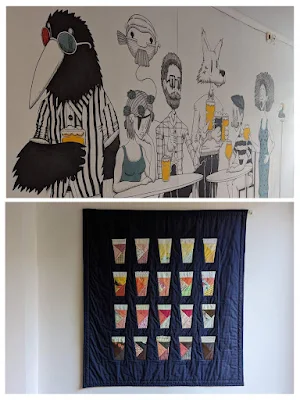




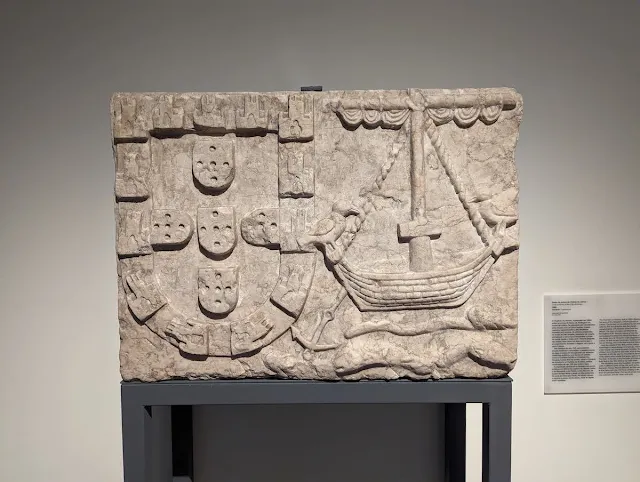

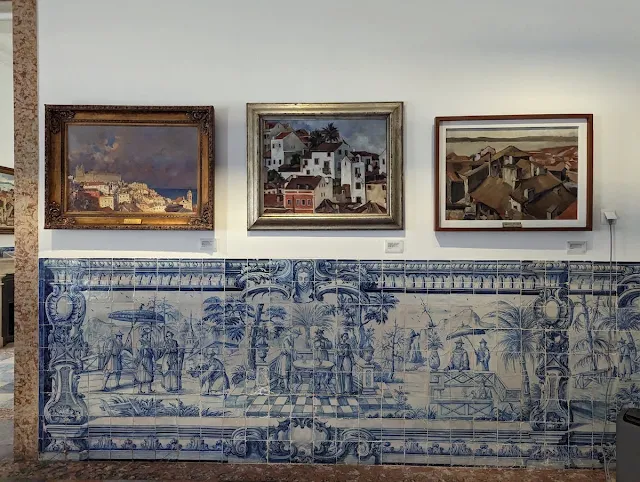
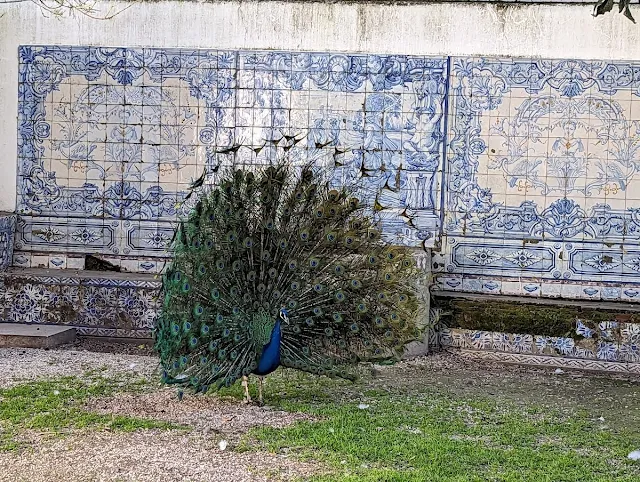

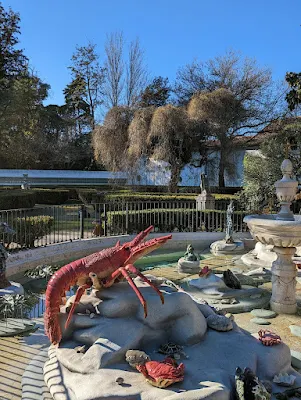

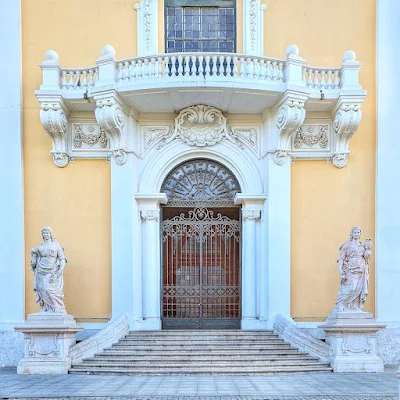


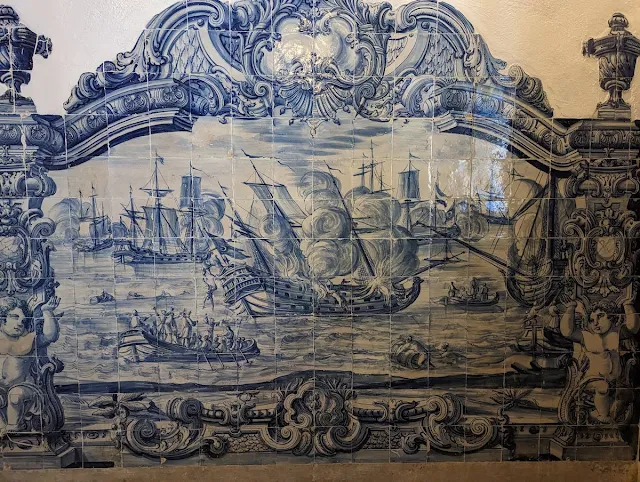

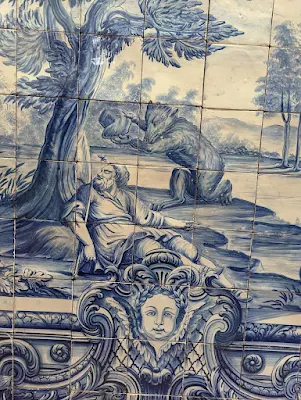


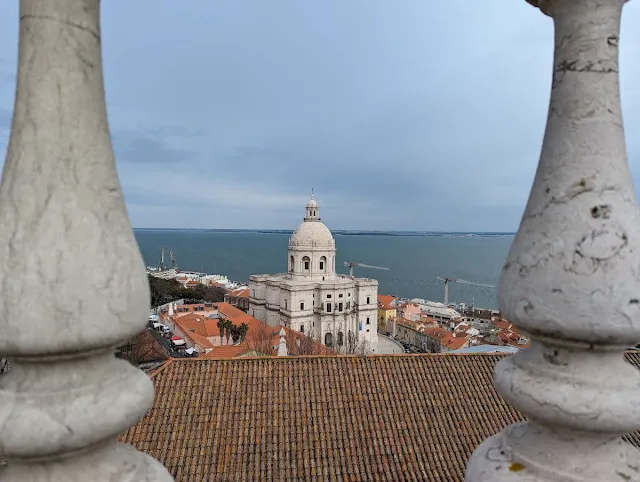






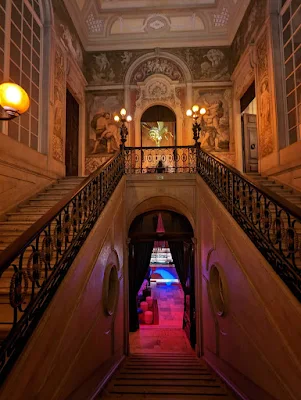


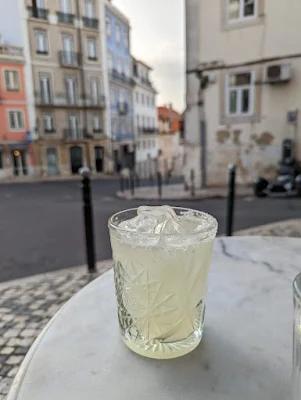
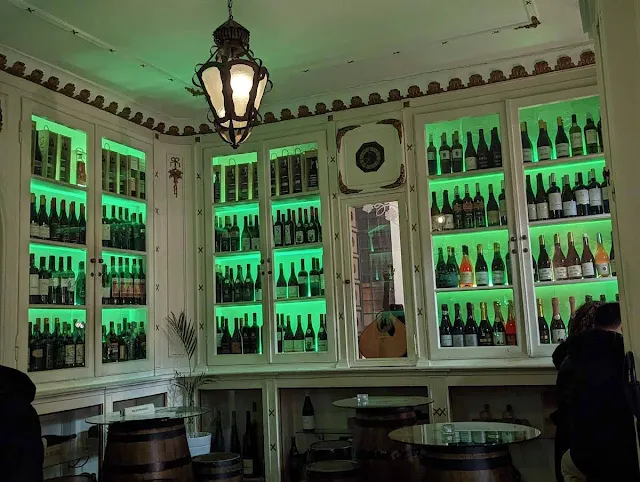
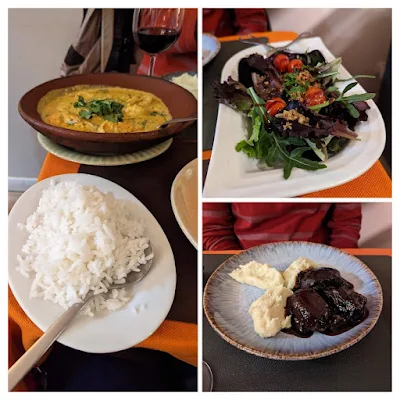





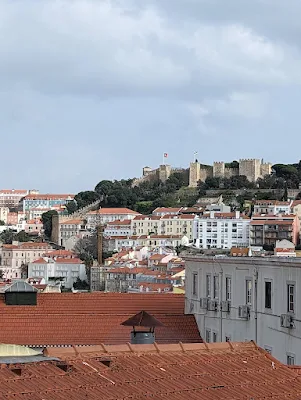
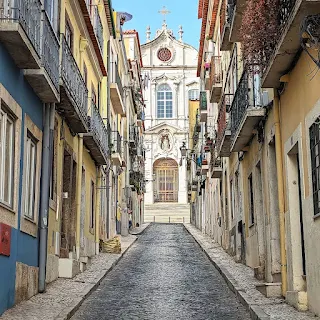




















.jpg)
